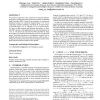518 search results - page 17 / 104 » Time Window Temporal Logic |
112
click to vote
TCS
1998
14 years 11 months ago
1998
A method is described for proving “always possibly” properties of specifications in formalisms with linear-time trace semantics. It is shown to be relatively complete for TLA...
NIPS
2003
15 years 22 days ago
2003
We show that temporal logic and combinations of temporal logics and modal logics of knowledge can be effectively represented in artificial neural networks. We present a Translat...
JLP
2008
14 years 11 months ago
2008
Currently known sequent systems for temporal logics such as linear time temporal logic and computation tree logic either rely on a cut rule, an invariant rule, or an infinitary ru...
ATAL
2005
Springer
15 years 5 months ago
2005
Springer
We present an approach to the verification of temporal epistemic properties in synchronous multi-agent systems (MAS) via bounded model checking (BMC). Based on the semantics of s...
CHI
2009
ACM
15 years 12 months ago
2009
ACM
We describe the use of a statistical technique called Tpattern analysis to derive and characterize the routineness of tasks. T-patterns provide significant advantages over traditi...

